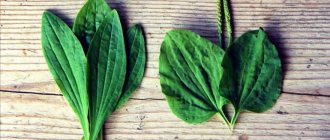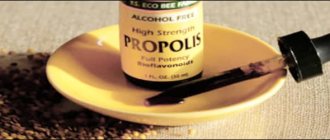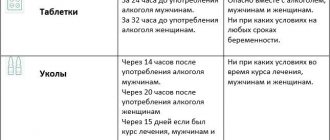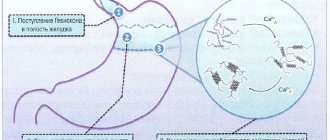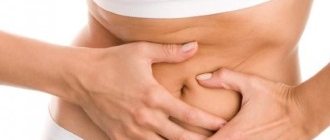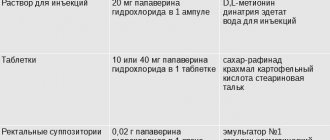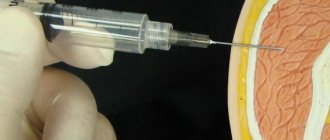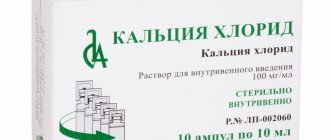Pharmacodynamics and pharmacokinetics
Herbal preparation. Crataegus plant includes organic acids (caffeic, oleanic, citric, crategusic, ursolic, chlorogenic), flavonoids (hyperoside, hyperin, quercetin, vitexin), carotenoids, fatty oils, tannins, triterpene glycosides, flavone glycosides, sugars, pectins, choline , beta-sitosterol and vitamins .
The active components of the drug reduce the excitability of the nervous system and myocardium, enhance the contractility of the latter, stimulate coronary and cerebral blood flow, and eliminate dizziness . Tincture of Crataegus flowers helps normalize heart rhythm, which is caused by a mechanism of action similar to that of class 3 antiarrhythmics.
Due to the presence of flavonoids and triterpene compounds, the drug has an antispasmodic effect, selectively relaxing the blood vessels of the brain and heart; hypotensive effect; helps regulate venous pressure, increases the reaction of vascular walls.
Research has revealed that hawthorn herbal preparations alcohol tincture and triterpene glycosides have a strong anti-atherosclerotic effect.
Tinctures of Peony, Hawthorn, Motherwort , Valerian have a similar effect.
The name of the plant comes from the Greek “strong”, which reflects either the property of the wood - strong and hard, or the ability of the plant to live long: the age of hawthorn can reach 300 years.
Hawthorns are tall shrubs, less often - trees up to 5-8 meters high with strong shoots, planted with thick, sparse thorns of stem origin. The flowers are white, fragrant, collected in corymbose inflorescences. The leaves and fruits vary from species to species. True to its name, the fruits of hawthorn are blood-red with 3–4 seeds. The leaves are dark green above, lighter below. It blooms in May–June, the fruits ripen in August–September. The plant bears fruit from the age of 10–15 years and can live up to 200–300 years.
The healing properties of hawthorn have been known since ancient times. For example, in surviving ancient manuscripts one can find references to the fact that hawthorn was widely popular and was used in the treatment of a number of ailments, especially in cases of cardiac dysfunction. In the East, hawthorn was called “wild apple tree”: the hawthorn tree really looks like an apple tree, especially with its leaves and roots. This was noted by Avicenna, who wrote that hawthorn “knits stronger than rowan, suppresses bile and blocks the flow more strongly than any other fruit.” Avicenna believed that hawthorn was harmful to the stomach, it “locks the stomach and does not retain urine.” The German doctor Jening noted back in 1896 that hawthorn has a positive effect on heart diseases, increases heart contractions and has a calming effect on the central nervous system (CNS). Some doctors achieved complete cessation of attacks of pain due to angina pectoris by giving patients hawthorn preparations. During the Great Patriotic War, hawthorn fruits were used as a substitute for heart medications that were in short supply at that time.
Many peoples call hawthorn a thorn: among the Germans it is a white thorn, among the British it is simply a thorn. Indeed, the thorn is the most noticeable part of the plant. By origin, hawthorn thorns are former twigs. If you look closely, you can see that at the very beginning of development, the soft and green spines have small leaves that quickly fall off. The grown thorns become incredibly strong, sometimes they are even used instead of nails. A large thorn pierces the foot through almost any sole, so you need to walk very carefully near hawthorns. The length of the spines is a species characteristic.
The blood-red hawthorn has a European-Siberian type of habitat, the length of which from west to east exceeds 5 thousand km. It grows in forest, forest-steppe and steppe zones in sparse dry forests, on forest edges and clearings, along river floodplains.
Hawthorn flowers and fruits are harvested as medicinal plant raw materials. The flowers are collected at the beginning of flowering, when some of them have not yet opened, by cutting off the thyroid inflorescences and individual flowers. Dry in dryers at a temperature of 40 ° C in attics, under canopies or in rooms with good ventilation. Hawthorn fruits are harvested during the ripening period from the end of September until frost, tearing off entire scutes with fruits or individual fruits. Dry in dryers at a temperature of 70 ° C. The shelf life of fruits and flowers is 2 years.
The State Pharmacopoeia of the XI edition includes 12 species of hawthorn permitted for procurement as medicinal raw materials. Hawthorn fruits and flowers are included in the State Pharmacopoeia as medicinal raw materials (two separate articles).
Unlike other medicinal plants, almost all parts of hawthorn, with the exception of the roots, contain a lot of useful substances. However, only fruits and flowers are used in medicine.
The flowers contain flavone glycosides hyperoside and quercitrin, which have the aglycone quercetin, but contain different sugars: hyperoside is quercetin-3-galactoside, quercitrin is quercetin-3-rhamnoside. Other phenolic compounds in hawthorn flowers include caffeic and chlorogenic acids. Acetylcholine, choline and trimethylamine were also found. The smell is caused by essential oil and some volatile compounds.
Hawthorn fruits contain hyperoside. Caffeic and chlorogenic acids, tannins (which are dimers of L-epicatechin and leucoanthocyanidin), triterpene compounds (ursolic and oleanolic acids), essential oil, β-sitosterol (the latter two substances in the seeds), sorbitol, choline and acetylcholine. Fresh ripe fruits are soft, mealy and tasty; their medicinal value is not much inferior to rose hips; they contain from 4 to 11% sugar, mainly fructose, so they can be eaten even if you have diabetes. Quite a lot of pectin, which not only forms jelly during processing, but also removes heavy metal salts and other harmful substances from the body.
Hawthorn is used as a cardiotonic and blood circulation regulating agent for palpitations, insomnia, and high blood pressure.
As a result of the use of hawthorn preparations in patients, their general well-being improves, blood pressure decreases, headaches, dizziness, noise in the head or ears decrease or disappear, the cholesterol content decreases (effective in the event of atherosclerotic plaques) in the blood and the concentration of lecithin increases, there is a tendency to normalization of blood clotting parameters. Hawthorn preparations are successfully used for symptoms of circulatory failure in elderly and senile people; they have a particularly beneficial effect on the blood supply to the brain; used for diseases of the menopausal period (both in women and men), thyrotoxicosis, atherosclerosis, angiotrophoneurosis, arterial hypertension, angina pectoris, atrial fibrillation and paroxysmal tachycardia, extrasystaly, insomnia, pneumonia, influenza-like diseases. Hawthorn has a slight sedative effect, regulating the functioning of the central nervous system, improves blood flow in the coronary vessels, and reduces body tension. Hawthorn helps improve memory and concentration. It is beneficial for patients with diabetes. The best effect is achieved with regular long-term use of hawthorn.
Hawthorn fruits are used for tachycardia, arterial hypertension, chronic heart failure (grades I–IIa), atherosclerosis, cardialgia, atrial fibrillation, paroxysmal supraventricular tachycardia, extrasystole, digitalis intoxication; insomnia, thyrotoxicosis, menopausal and asthenoneurotic syndrome. Fruits are contraindicated in case of hypersensitivity, in childhood (up to 12 years) and during pregnancy (first trimester). Use internally in the form of tincture and extract, 20–30 drops 3–4 times a day. In the form of an infusion - 15-30 ml 2-3 times a day. Side effects may include allergic reactions (urticaria, itching), bradycardia (with prolonged use); when used in large doses – decreased blood pressure, drowsiness. When administered together with cardiac glycosides, the cardiotonic effect is enhanced; with β-blockers – hypotensive effect.
Hawthorn tincture is used as part of complex therapy for functional disorders of the heart, cardialgia, menopausal syndrome, and asthenoneurotic conditions. Prescribed orally: for adults – 20–30 drops 3–4 times a day before meals (course of treatment is 20–30 days); children over 12 years old - 10-15 drops, diluted in 1/4 glass of water 3-4 times a day before meals (course of treatment is 20-30 days). The tincture should be used with caution in case of liver diseases, alcoholism, traumatic brain injury, and brain diseases. The absolute alcohol content in the maximum single dose of the drug for adults is 0.45 g, for children – 0.23 g; in the maximum daily dose of the drug for adults - 1.8 g, for children - 0.9 g. During the treatment period, care must be taken when driving vehicles and engaging in other potentially hazardous activities that require increased concentration and speed of psychomotor reactions.
Hawthorn flowers have antiarrhythmic and hypotensive effects, improve coronary and cerebral circulation, and reduce heart rate. Reduce the excitability of the central nervous system, reduce cholesterol in the blood and increase the amount of lecithin; normalize blood clotting indicators. With hypogalactia, lactation is increased and dyspeptic symptoms in infants are eliminated. The hypotensive effect is more pronounced than that of hawthorn fruits. Use internally as an infusion of 15–30 ml 2–3 times a day. To prepare the infusion, 5 g (1 tablespoon) of raw material is placed in a glass or enamel container, poured with 200 ml of water, covered with a lid and heated in a boiling water bath for 15 minutes. Cool at room temperature for 45 minutes, filter, and squeeze out the remaining raw materials. The volume of the resulting infusion is adjusted to 200 ml with boiled water. Allergic reactions are possible as side effects; bradycardia (with prolonged use); nausea, vomiting, intestinal colic (when taken on an empty stomach).
The liquid extract of the fruit is part of the complex preparation Cardiovalen (adoniside + hawthorn fruit extract + valerian officinalis rhizomes with roots tincture + gray jaundice juice + camphor + sodium bromide). It has a cardiotonic and sedative effect and is indicated for the initial stage of chronic heart failure and cardiopathy. Apply 15–20 drops orally 1–2 times a day.
For insomnia and heart neuroses, a mixture of hawthorn and valerian preparations works well.
It must be remembered that prolonged and uncontrolled use of hawthorn preparations can cause depression of heart rate.
The fruits of large-fruited hawthorn species are quite tasty; they can be eaten fresh, processed into jam, wine, compote, and brewed as tea. However, hawthorn should not be overused. It is not recommended to eat more than a glass of berries at one time, as this can cause a sharp drop in blood pressure and heart rhythm disturbances. One rosette of hawthorn jam replaces a double dose of such a strong heart remedy as adonizide. Hard hawthorn wood is used to make wooden products. The bark is used to dye fabrics red. The fruits are used to make jam, jelly, substitute coffee and tea. Dried berry flour is added to dough to create bread with a fruity flavor.
Information about the authors: Samylina Irina Aleksandrovna - Doctor of Pharmaceutical Sciences, Professor, Corresponding Member of the Russian Academy of Medical Sciences, Director of the Research Institute of Pharmacy; Head of the Department of Pharmacognosy MMA named after. THEM. Sechenov. Tel.; Sorokina Alla Anatolyevna - Doctor of Pharmaceutical Sciences, Professor of the Department of Pharmacognosy of the MMA named after. THEM. Sechenov. Tel.; Pyatigorskaya Natalya Valerievna - candidate of pharmaceutical sciences, associate professor, deputy director of the Research Institute of Pharmacy for scientific work. Tel.
Analogs
Level 4 ATC code matches: Vasonate
Phosphaden
Hawthorn fruit
Preductal
Meldonium
Angiosil Retard
Ranexa
Lily of the valley tincture
Neocardil
Rimecore
Triductane
ATF-Long
Triductan MV
Trimectal MV
Trimectal
Neoton
Predisin
Trimetazidine
Tivortin Aspartate
Metamax
Hawthorn (tablets) , Doppelherz Active Cardiovital, Cardioplant, Plantiscardio, Hawthorn Forte Evalar.
special instructions
The list of diseases for which taking hawthorn drops is contraindicated:
- Patients with diseases of the gastrointestinal tract (gastritis, peptic ulcer, enteritis), liver, gall bladder. The alcohol infusion irritates the mucous membrane and intensifies the inflammatory process.
- Women planning or already during pregnancy, as well as those who are breastfeeding. 40% ethyl alcohol and any alcohol in the composition disrupt the process of fetal ripening and easily penetrate into milk.
- Alcohol-containing products are contraindicated for transport drivers and persons whose work requires a quick reaction. Taking drops causes drowsiness, weakness, and decreased concentration.
- After traumatic brain injury, stroke.
The benefits of the herbal remedy that are written about:
- natural composition;
- vitamins A, C, E and B, fatty acids and microelements;
- quick onset of action and effectiveness when taken regularly;
- general strengthening, tonic effect on the cardiovascular and autonomic nervous system;
- with a combination of alcohol drops and beta-blocker tablets - an effective reduction in blood pressure (for hypertension), at a high risk of hypotension.
The tincture can be harmful to health if it is used incorrectly from pharmaceutical products, or if it is prepared at home in violation of the recipe. Do not exceed the dosages indicated in the instructions or extend the course. If the condition worsens or one of the side effects develops, you should contact a physician, cardiologist or neurologist.
Price of Hawthorn Tincture, where to buy
The price of Hawthorn Tincture 25 ml is approximately 14 rubles in Russia, and 3.5 hryvnia in Ukraine.
- Online pharmacies in RussiaRussia
- Online pharmacies in UkraineUkraine
Pharmacy Dialogue
- Hawthorn tincture (flask 25ml) Kirovskaya FF
66 rub. order - Hawthorn tincture (flask 25ml) Hippocrates
25 rub. order
- Hawthorn tincture (flask 25ml)Flora of the Caucasus
16 rub. order
- Hawthorn tincture (flask 25ml) MFF
19 rub. order
show more
Pharmacy24
- Hawthorn tincture 100 ml PAT "Khimpharmzavod" Chervona Zirka", Kharkov, Ukraine
9 UAH. order - Hawthorn tincture 100 ml PrAT FF "Viola", Ukraine
9 UAH order
- Hawthorn tincture 100 ml TOV DKP Pharm.Fabrika, Ukraine
11 UAH order
- Hawthorn tincture 100 ml PRAT "Fitofarm", Ukraine
9 UAH order
- Hawthorn tincture 100 ml PAT "Lubnifarm", Ukraine
9 UAH order
Procurement of raw materials
When properly prepared, homemade hawthorn tincture turns out to be useful, the raw materials for which can be purchased at a pharmacy or prepared independently in places remote from industrial zones and major highways.
Flowers are collected during the period of mass appearance of buds in early June. The inflorescences are selectively cut off and placed in a spacious basket.
The leaf collection season begins in spring and ends after flowering. Select whole, undamaged leaf blades, cutting them with scissors or carefully tearing them off with your hands. On each branch there should be at least 2/3 of the previous volume of greenery.
Ripe fruits are harvested starting at the end of September. The harvest must be sorted, discarding deformed, rotten, damaged berries and debris.
Flowers and leaves are scattered under the canopy in a thin layer. The raw materials are turned over every day. The berries are laid out on a sheet and placed in the oven, setting the heat to 50 degrees. Periodically open the door and stir the fruit to ensure even drying.
conclusions
Hawthorn tincture is an auxiliary medicine used for the treatment and prevention of disorders of the nervous and cardiovascular systems. The herbal preparation has a general strengthening and tonic effect, improves blood circulation, general and psycho-emotional state. The therapeutic effect is observed when taken as a course. The remedy cannot be used as self-treatment for any already diagnosed pathology - use it only if it has been recommended to you by a doctor. Neglecting to take the necessary protocol medications will significantly worsen the condition, as will replacing them with tinctures.
